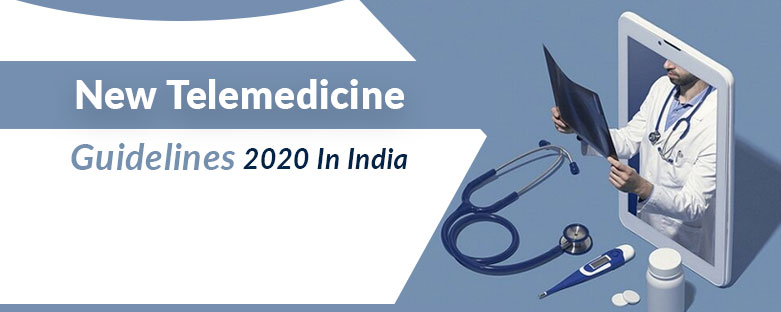New Telemedicine Guidelines 2020 in India
In the present COVID-19 pandemic situation, where face-to-face appointments are challenging, the Medical Council of India (‘MCI’) has legitimized the practice of telemedicine by registered medical practitioners, offering considerable relief to doctors and patients. Telemedicine Guidelines are is a very popular topic in India.
Telemedicine offers an ideal way not only to provide timely and quicker entry but also to reduce travel-related financial costs. It also removes inconvenience/impact for families and caregivers and other social variables and particularly in situations when there is no requirement for the patient to see RMP clinically, e.g. for normal, frequent check-ups or constant supervision. It may reduce the pressure on secondary hospitals substantially. It may also offer easy access to emergency personnel who may not be present in person immediately.
These recommendations account for doctor-patient partnership requirements and procedures, responsibility and neglect concerns, assessment, supervision and treatment; informed consent, quality of care, referrals to emergency departments, medical history, protection and confidentiality of patient data and information sharing, prescription, and reimbursement; clinical education and counselling.
With the telemedicine guidelines in place, clinicians would be able to prescribe medications based on audio, text, or video conversations — chat, videos, messaging, emails, faxes, and others. This will help users to contact licensed medical practitioners without leaving the house and further reduce the risk of transmission.
Introduction to New Telemedicine Guidelines:-
The Telemedicine Guidelines require a doctor to “prescribe medicines by telemedicine only if (the doctor) is confident that he/she has obtained appropriate and valid information on the medical state of the patient and the recommended medicines are in the patient’s best interest” in order to prevent abuse. Prescribing pharmaceutical drugs without a clear examination / provisional examination would be clinical incompetence.
Even the government has listed some medications that cannot be administered by telemedicine. This covers medications specified in Schedule X of the 1985 Medications and Psychotropic Substances Act and all Narcotics and Psychotropic Substances Act.
What is Telemedicine?
Telemedicine includes using electronic communications and software to connect patients without an in-person appointment for health facilities. Telemedicine technology is also used for follow-up visits, chronic illnesses management, drug control, expert support, and a variety of other health services that can be accessed directly via secure video and audio connexions. New technology has allowed doctors to consult patients using HIPAA compliant video-conferencing tools.
Telemedicine was originally developed as a way of helping patients in remote areas, far from local health centers, or in locations where telemedicine service providers were in limited supply
Who can Provide Telemedicine Facilities in India?
Telemedicine can be performed in India only by a Registered Medical Practitioner (‘RMP’), i.e. a person who is enrolled in the State Medical Registry or the Indian Medical Registry under the Indian Medical Council Act, 1956. In addition, any RMP offering telemedicine is subject to the same technical, legal requirements, and requirements.
RMPs wishing to practice telemedicine need to be conversant with the provisions of the standards as well as with the practice procedure and restrictions. For this reason, the Board of Governors may undertake a mandatory 3-year online course. However, any RMP can practice telemedicine within the interim period by adhering to the provisions of the guidelines.
What are the Latest Amendments for Telemedicine?
A registered medical practitioner under the Indian Medical Council Act, 1956, is a person who is enrolled under the Indian Medical Council Act, 1956 (or National Medical Commission Act, 2019 as and when it comes into full force and replaces the Indian Medical Council Act, 1956) in the State Medical Register or Indian Medical Register. By statute, any practicing physician in India today is mandated to be registered in the State Medical Registry or Indian Medical Registry before his or her medical practice starts. Consequently, the amendment did not add any new identification provision for doctors who wish to practice telemedicine and offer teleconsultation to their patients.
In addition, the amendment specifies that the Telemedicine Practice Guidelines (‘Guidelines’) would not extend to the use of emerging devices to remotely perform surgical or invasive procedures.
Telemedicine Guidelines – Salient Features:-
- During teleconsultation, doctors must maintain the same level of care as during in-person consultation: The Telemedicine Guidelines mandate doctors during teleconsultation to ensure the same quality of treatment for a patient as they might during an in-person consultation. In other words, it cannot be used as a shield by a doctor against an accusation of medical negligence that the teleconsultation took place over a mobile app, or email or telephone. Each doctor is expected to know of the teleconsultation restriction and to advise or recommend accordingly.
- Invoice for payment: Physicians can charge appropriate teleconsultation payment. The patient should be given a receipt or an invoice against the payments.
- The means of teleconsultation may be used by a doctor: a doctor may use any means for patient consultation, such as smartphone, cell or landline telephones, chat platforms such as WhatsApp, Facebook Messenger, etc., other mobile apps or internet-based telemedicine digital services, or data transfer systems such as Skype/email/fax, etc.
- The patient is responsible for the quality of the details: during the teleconsultation process, if the physician asks the patient for the appropriate information, the patient should give the correct information. It has been explained in the Telemedicine Guidelines that the patient is responsible for the quality of the details exchanged with the doctor, and not the doctor.
What is the Impact of the Telemedicine Guidelines on Doctors and Patients?
Telemedicine makes documents and data easier to manage. While the risk of ignoring the doctor’s recommendation is minimized. The doctor, on the other hand, has an exact document of the advice given via teleconsultation. Written documentation increases both parties’ legal protection. In cases where there is a risk of viral diseases, such as the latest Covid-19 pandemic, telemedicine also guarantees the safety of the patient as well as the safety of the doctor.
The Telemedicine need those physicians who perform teleconsultation to commence patient care only after the physician is confident that appropriate and specific information on the medical status of the patient and the prescribing of medications that are in the best interest of the patient has been obtained. Otherwise, the practitioner does not administer the patient’s medicine. If in breach of the Telemedicine Rules, the doctor prescribes a patient, he/she risks losing his / her registration with the appropriate State Medical Council, i.e. the license to practice medicine on the pretext of clinical misconduct.
Telemedicine makes it easy for caregivers to check up and ensure that it goes smoothly for patients. If they use a more comprehensive remote patient tracking device to track the patient’s pulse, whether they do a video chat to answer drug questions during a hospital discharge – telemedicine contributes to improved treatment results.
Not only does telemedicine offer prompt and quick access, but it can also provide an ideal solution. That will also reduce travel-related financial expenses. It also decreases families and caregivers and social causes inconvenience/impact. In situations where there is no need for the patient to see the RMP (or another medical professional) personally, such as for daily, routine check-ups or constant supervision, telemedicine may play an especially important role. Telemedicine will lower the pressure on secondary hospitals.
Conclusion:
Dreamsoft4u Pvt. Ltd. is one of the best Telemedicine Companies in the USA and India. We maintained a highly favorable rating among physicians and patients. We have clients range from hospitals, rural clinics, blood processing agencies, individual physicians and full-service hospitals. We offer planning, system integrations migrations, and many more. Our Healthcare IT Solutions make your staff hassle-free so they can focus on patient and client requirements.





Thanks for sharing new guidelines for telemedicine with us.
Your article gave me a lot of inspiration, I hope you can explain your point of view in more detail, because I have some doubts, thank you. 20bet